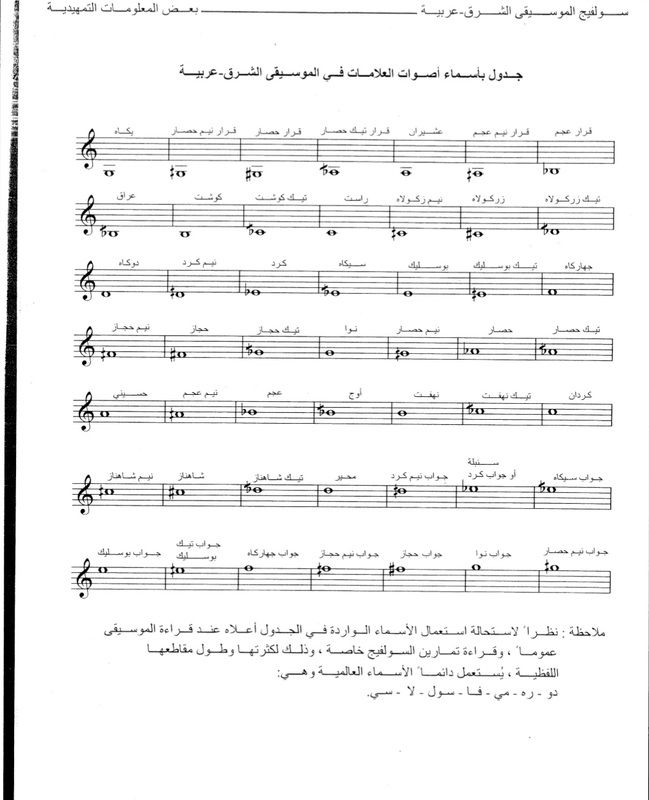newlife_ks
Oud Junkie
    
Posts: 119
Registered: 6-12-2016
Location: Germany, NRW
Member Is Offline
|
|
Note Names
Hello everybody!
Somewhere on the web I found a diagram covering two octaves from G to g2 including the original arabian note names and all of the microtonal names
too. Starting from G/yakah, A/ushayran up to g2/ramal tuti. Now this diagram misses the note names down from G to the lower C string.
I just want to know them because I'm working on Charbel Rouhana's book which in its preface sometimes mentions note names without further explanation.
Well, he's surely arabian spoken and knows them, but not me being german.
So I'd be glad if someone can provide a complete list or a link.
Greetings from Klaus in Germany!
|
|
|
bulerias1981
Oud Junkie
    
Posts: 770
Registered: 4-26-2009
Location: Beacon, NY
Member Is Offline
Mood: John Vergara Luthier Lord of the Strings instrument making and repair
|
|
Here's the note names from my "Oriental Solfege" workbook I studied out of whilst in Lebanon back in 2010.
Within a couple weeks I had them all memorized, but forgot half of them by now. There is some correlation between the maqamaat and the names, so it is
very interesting actually.

|
|
|
newlife_ks
Oud Junkie
    
Posts: 119
Registered: 6-12-2016
Location: Germany, NRW
Member Is Offline
|
|
Hello John!
Thanks for your reply! Unfortunately it does not help me much in two ways. First - I can't read arabian letters. Second - your diagram misses the
notes down from G to C which I was looking for. 
Greetings from Klaus in Germany!
|
|
|
bulerias1981
Oud Junkie
    
Posts: 770
Registered: 4-26-2009
Location: Beacon, NY
Member Is Offline
Mood: John Vergara Luthier Lord of the Strings instrument making and repair
|
|
This does go down to G, which is yekah however, as far as I know the notes like the low C and those have no names since that was added later?
|
|
|
Brian Prunka
Oud Junkie
    
Posts: 2939
Registered: 1-30-2004
Location: Brooklyn, NY
Member Is Offline
Mood: Stringish
|
|
Here is a chart with transliterated names:
http://oudipedia.info/arabnotes.html
Some of these disagree with other sources, noted below.
John is correct, the lowest theoretical note in the maqam system corresponds to Yekah (low G), everything below that is a technical addition to the
oud and not really part of the maqam system (i.e., it's for playing octaves, drones, and other support, or for echoing a higher idea an octave
down).
Of these, the practical terms to know are:
G - Yekah
A - Ushayran
Bb - Ajam Ushayran (I've heard this more than qarar Ajam)
B/b - Iraq
C - Rast
D - Dukah
Eb - Kurd
E/b - Sikah
E - Buselik
F - Jiharkah
F#/Gb - Hijaz
G - Nawa
G#/Ab - Hisar
A - Husayni
Bb - Ajam
B/b - Awj
C - Kirdan
C#/Db - Shehnaz
D - Muhayyer
Bold indicates the ones I would consider essential to know
|
|
|
newlife_ks
Oud Junkie
    
Posts: 119
Registered: 6-12-2016
Location: Germany, NRW
Member Is Offline
|
|
Dear Brian!
Thanks a lot for your explanations!
Greetings from Klaus in Germany!
|
|
|
John Erlich
Oud Junkie
    
Posts: 1470
Registered: 8-26-2004
Location: California, USA
Member Is Offline
Mood: Oud-Obsessed
|
|
Quote: Originally posted by bulerias1981  | Here's the note names from my "Oriental Solfege" workbook I studied out of whilst in Lebanon back in 2010.
Within a couple weeks I had them all memorized, but forgot half of them by now. There is some correlation between the maqamaat and the names, so it is
very interesting actually.
 |
Hi John,
Thanks so much for posting this! Is there any chance of posting or emailing me a higher resolution copy, especially for those of us with limited
Arabic reading skills?
Peace out,
"Udi" John
|
|
|